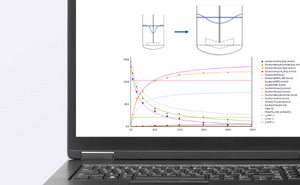Kinetic Modeling and Validation of Palladium-Catalyzed Reductive Carbonylation
Synthesis of a Boehringer's Late-Stage API Intermediate
Program Overview
- Key strategies in kinetic modeling
- Implementation of digital tools
- Data-rich experimentation
- Process scale-up techniques
Heteroaryl aldehydes serve as critical intermediates in the synthesis of biologically active compounds. The Pd-catalyzed formylation of aryl bromides has become a notably efficient method to produce carbonyl compounds among several other available methods. In reductive carbonylation processes, carbon monoxide (CO) is combined with a hydrogen donor, such as silyl or tin hydrides, or formate salts, to facilitate formylation. Among the various sources of CO and hydrogen for achieving formylation, synthesis gas (syngas, CO/H2) stands out as an environmentally friendly and atom-efficient option due to its accessibility and cost-effectiveness. While several aryl bromides have been successfully carbonylated using syngas, certain heteroaryl bromides pose challenges due to their propensity to undergo reductive dehalogenation.
In this study, we demonstrate the application of Pd-catalyzed syngas carbonylation for the synthesis of a Boehringer’s advanced API intermediate. During the process development, it was deemed essential to minimize the formation of dehalogenated byproduct during the syngas-mediated carbonylation. To achieve this, we developed a mechanism-based kinetic model using Reaction Lab software, which was employed to generate in-silico predictions aimed at reducing ArH. These predictions were subsequently validated through experimentation and further employed in the multi-kilo scale production of API.
- Discover how to build and validate a kinetic model that supports large-scale synthesis of drug substances.
- Understand the role of predictive technologies and artificial intelligence in optimizing reaction outcomes and catalyst development.
- Learn about the use of high-throughput screening and multivariate modeling to enhance reaction conditions and yields.
- Gain insights into transitioning reactions from lab scale to multi-kilogram scale while ensuring high selectivity and yield.
Target audience
This webinar is ideal for process chemists, chemical engineers, and anyone involved in drug development and synthesis looking to enhance their understanding of kinetic modeling and digital integration in chemical processes.
Speakers

Sanil Sreekumar
Boehringer Ingelheim
Sanil Sreekumar is a Senior Principal Scientist in Chemical Development. He joined Boehringer Ingelheim in Ridgefield, CT in September 2020 and since then, he has been leading process development in the catalysis group and spearheading application of in silico and machine learning tools within Chemical Development. Sanil brings to his position a well-established background in synthetic organic chemistry. Prior to joining BI, he worked as a Senior Scientist at Dow Chemicals in MI and later worked as a Research Investigator at DuPont following DowDuPont spinoff. Sanil obtained his PhD degree in synthetic organic chemistry from the University of Liverpool, UK. During his graduate studies, he worked on natural product synthesis with Prof. P. Andrew Evans. Following his doctoral studies, he pursued postdoctoral education with Prof. F. Dean Toste from UC Berkeley, CA where he worked on the biofuel and bio-lubricant syntheses.



